Piel de Sapo Melon sorbet
Tempted to try some Toad-skin melon? You should be – because this is probably the best melon sorbet that I have ever had!
Melons belong to the same plant family as cucumbers (Cucurbitaceae). And while this recipe will work with any melon, I chose a Piel de Sapo – which made for a phenomenally nice sorbet!
We have many names for the things we love, and the Piel de Sapo melon certainly seems to be much loved!
“Piel de Sapo” (‘toadskin’) refers to its characteristic (mainly) green-striped rind. Its other names – “the Santa Clause melon” or “the Christmas melon” – supposedly refer to its long-keeping qualities [it does keep much longer than other melons] and/or the fact that it has its peak season around Christmas.
While grown in many places, the Piel de Sapo is apparently the melon of choice in Spain. The inside looks quite similar to that of a Honeydew melon, but the mellow, mildly flavoured pale, greenish flesh is markedly sweeter (in a pleasant way!). As goes for melons in general, it is low in calories, fat-free, and packs a lot of vitamin C and dietary fibre.
Sorbet base with improved consistency? Try Agar agar!
I have taken the cues of proportions from Swedish Master confectioner Jan Hedh for the sorbet recipe. He, however, tends to be very keen on using gelatine to improve the consistency of his ice creams (and sometimes also his sorbets). Instead, I turned to a natural, vegetable alternative – Agar agar! But first of all, let me underline that this recipe works very well also without Agar agar. But – if you can get hold of this natural, vegetable gelling agent, do give it a try! You might be quite impressed by the positive effects it has on the texture and consistency of the final sorbet!
Agar agar is similar to gelatine in performance (can absorb liquid about twenty times its own weight), but is made from red algae or seaweed. Because Agar agar consists of about 80 % fibre and almost no calories, it has long been a popular bulking agent in Japan, where it is called Kanten. Kanten diets have also been quite popular there, so if you are interested in losing some weight to justify your ice cream-consumption, you might give it a thought:-) .
Preparing the sorbet
As with most sorbets, preparing a simple sugar syrup is a good first step. Because some sugar is added to the flesh of the melon, you will notice that the proportions sugar/water for the simple sugar syrup deviate from the standard 50/50-formula.
Cut the melon, remove the seeds and purée the fruit. Add about 50 gram of sugar – more should not be necessary, provided the melon is sufficiently ripe (you might even get away with less).
Then, mix the fruit purée with the simple sugar syrup. If you want to check that the base is sweet enough/not overly sweet, do the Egg test.
Take some of the resulting sorbet base and use for dissolving the agar agar. Agar agar is insoluble in cold water, so you need to heat it up in a small quantity of the liquid. When that liquid begins to cool down again, the agar agar will begin to solidify (at 37° Celsius (98.6° F), to be exact).
This will happen relatively quickly here, since the next step is to whisk together the now dissolved agar agar-liquid with the rest of the sorbet base: in other words, work quickly!
If you like, you may add some lemon juice to the sorbet base to counter-act a too sweet end-result (but since the cold tends to dull most flavours, you may well decide to live without any lemon juice added too).
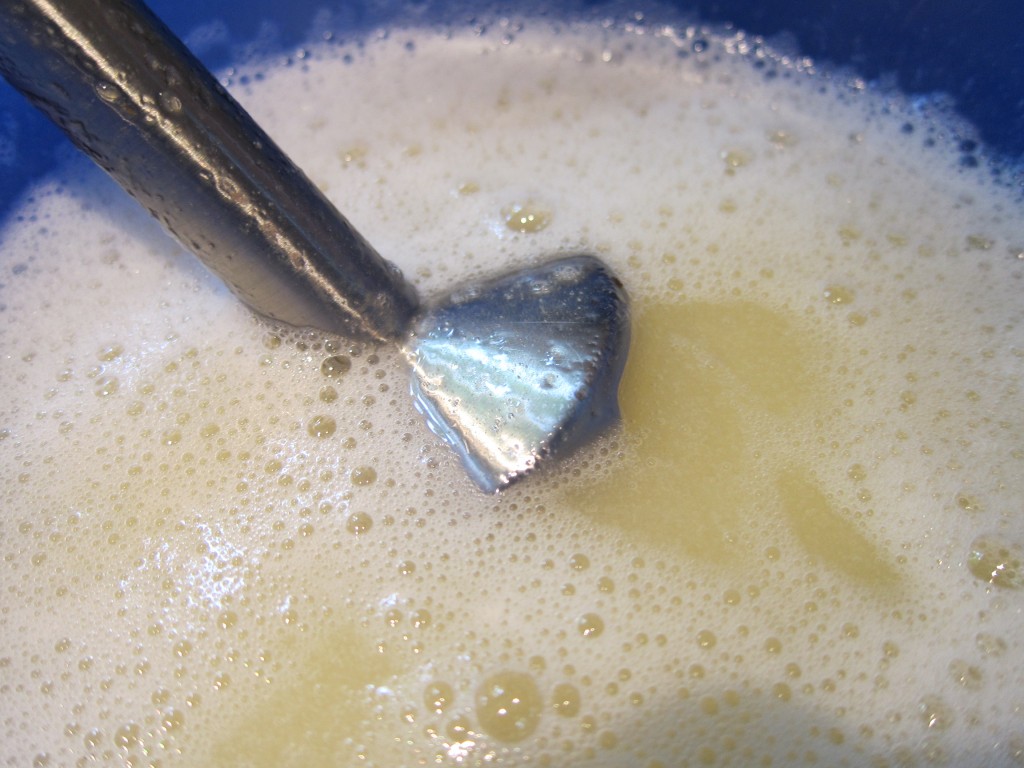
Finally whisking it all together. The foam is caused by the agar agar, but will leave no visible traces in the final sorbet. But whisk quickly – you do not want the agar agar to start solidifying into chunks of its own at this stage!
The final result
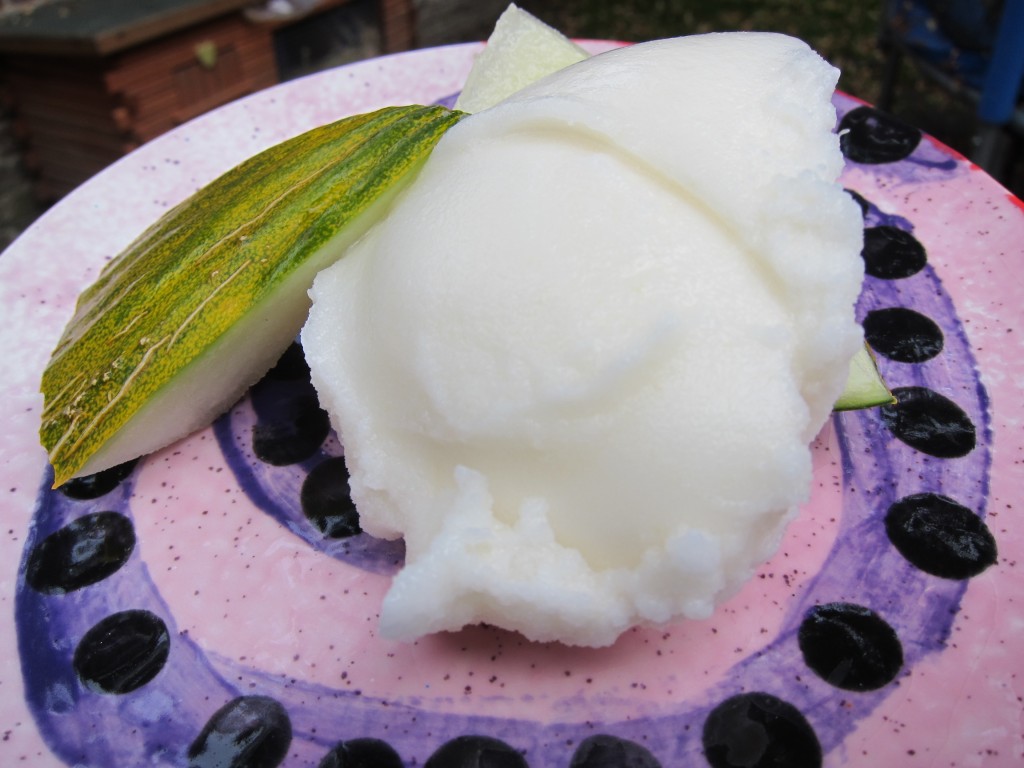
Fantastic melon sorbet, made on Piel de Sapo melon, and with Agar agar for improved texture and consistency
Excellent sorbets, vibrating with rich and pure frozen flavours – is there anything better? This recipe definitely falls within this top category: both me and my daughter (who assisted me in preparing the recipe) immediately agreed that this was the best melon sorbet we had ever enjoyed. Later on, friends and the rest of the family also gave their thumbs up.
Clearly, the combination of a ripe Piel de Sapo melon and a little Agar agar turns out to be a splendid combination. Great texture and consistency, paired with an alluringly sweet and distinct melon flavour!
Still – do not feel sad if you have neither a Piel de Sapo, nor Agar agar: the recipe will also work very well with other melons and without agar agar.
No ice cream machine? Do not worry!
I have successfully tried the recipe (without agar agar, and with other melons) still-frozen, without using any ice cream machine. Typically, your greatest challenge then will probably be to reduce the size of the ice crystals as much as possible, by vigorous churning by hand every now and then during the freezing. But believe me – the end result will be worth it!
- 450 gram melon purée (tends to require a melon about double that weight)
- about 50 gram sugar
- 350 ml ( about 1.5 cups) simple sugar syrup (proportions 150 ml (2/3 cup) sugar, and 200 ml (7/8 cup) water)
- (optional, but recommended) about 2 gram Agar agar
- (optional) lemon juice from about ½ lemon, depending on taste
- Prepare the simple sugar syrup by mixing water and sugar (by heating it, or simply by shaking it). Let cool down.
- Cut the melon, remove the seeds and purée the fruit, together with the 50 gram of sugar.
- Mix together the sugar syrup and the fruit purée. If you want to make sure that you have the appropriate level of sweetness for sorbet, do the Egg test.
- Take about 100 ml (about 0.4 cup) of the mixture, heat to about 40° Celsius (104 °F) and quickly whisk in about 2 grams of Agar agar.
- When well dissolved, pour back into the rest of the mixture, whisk well and churn in your ice cream machine according to its instructions.
- In case you worry that the sorbet might become too sweet for you, add lemon juice from about ½ lemon (according to your taste) to the base before churning it.
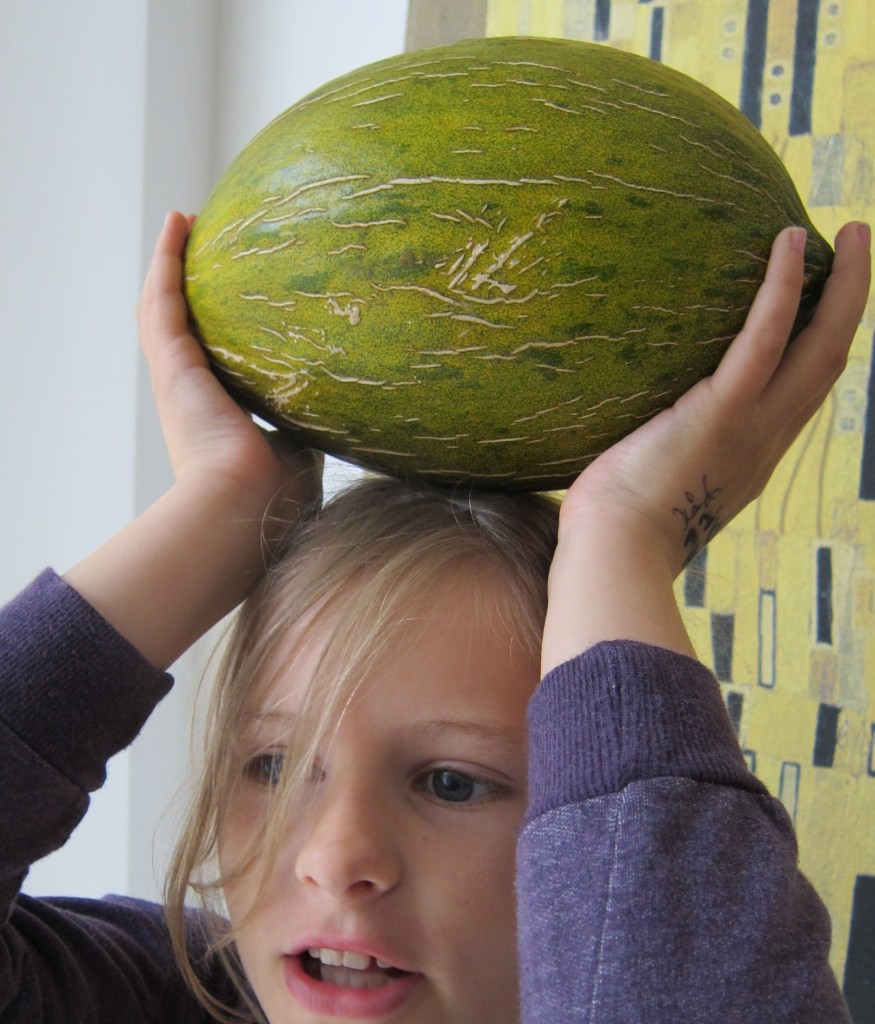
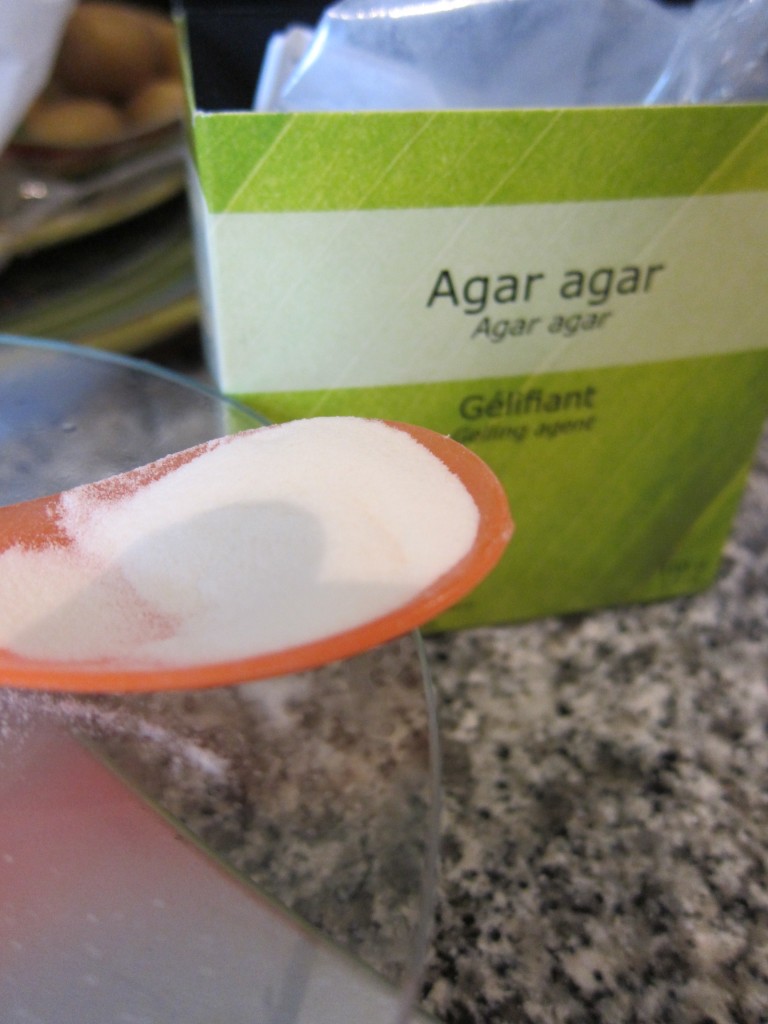
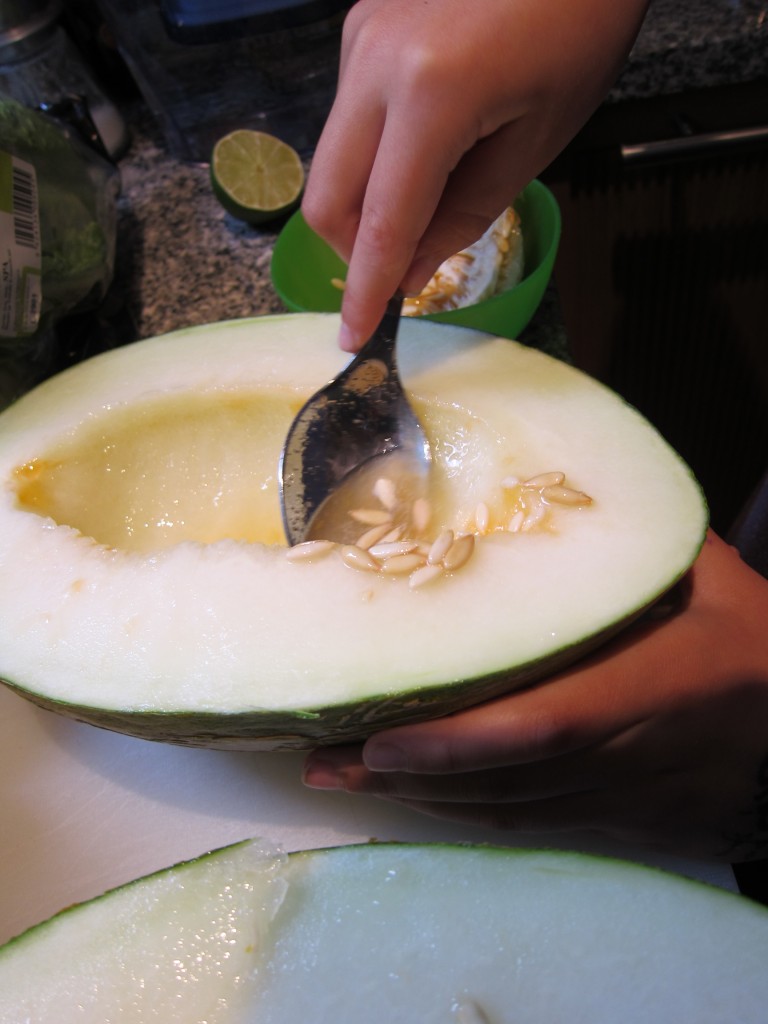
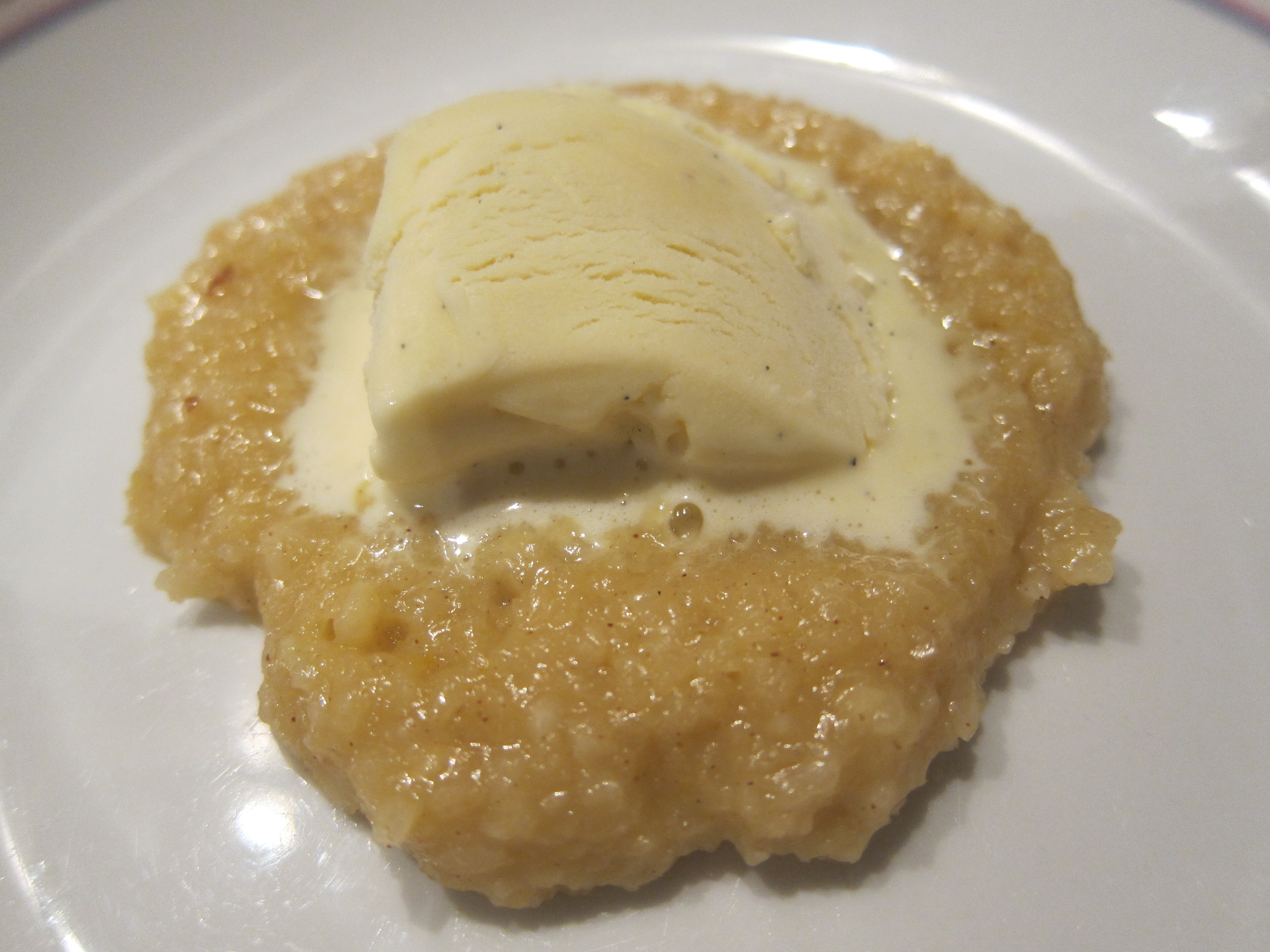
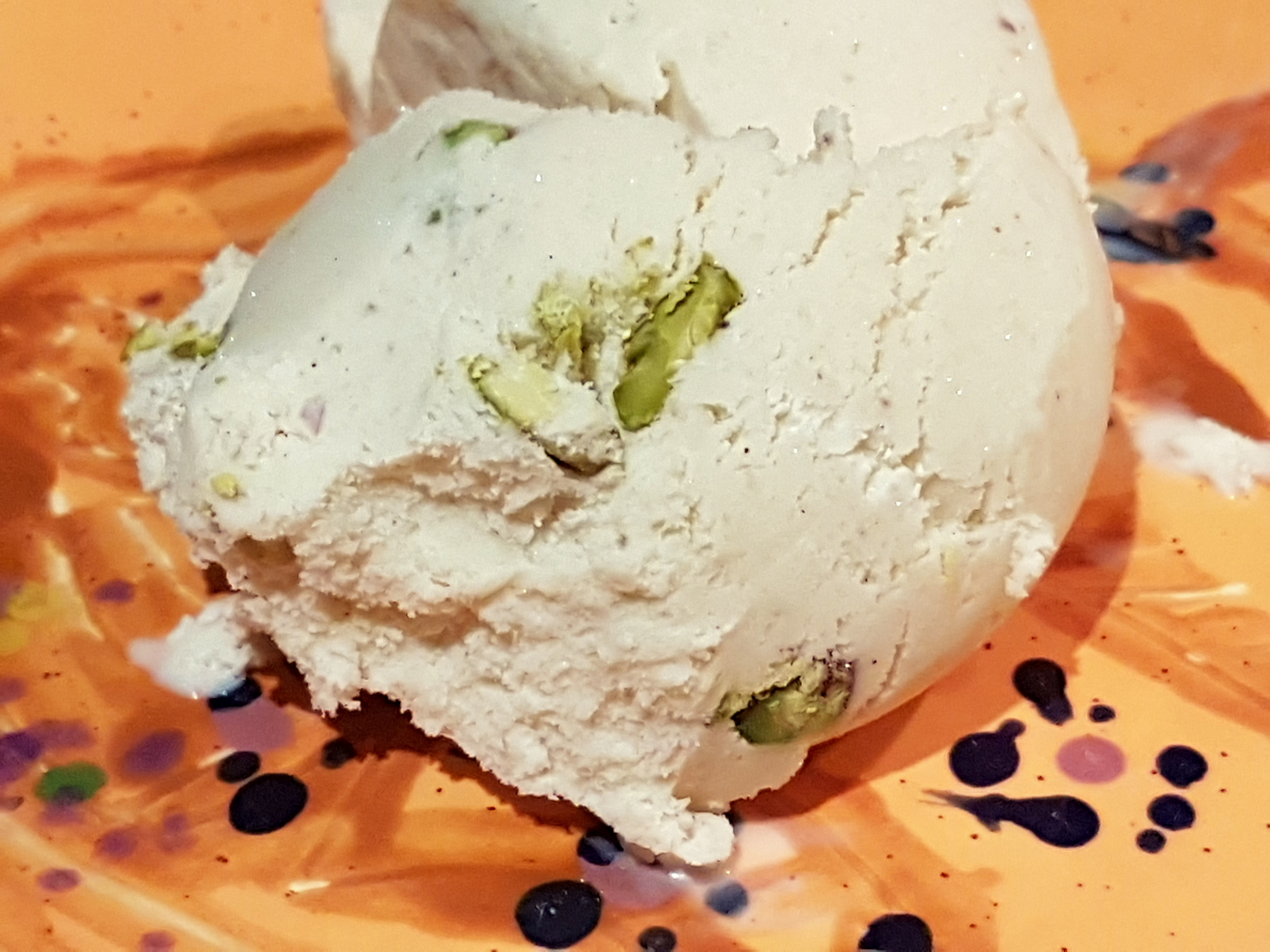
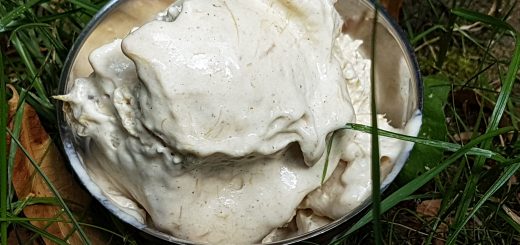


I have never tried agar- agar in sorbet..Althought gelatine is sometimes used in store-bought popsicles..I have to give it a try! Is the amount of used agar somewhat “universal”? Will it differ when I use it in sorbet made with bigger amount of alcohol (e.g.campari and grapefruit). The alcohol based sorbets tend to be softer and dissolve so quickly – it woud fe fine to slow the process a bit:)
Hi Katerina! Nice to hear from you again:-)
Yes, I think the amount is supposed to be quite “universal” for the amount of sorbet liquid used in the recipe. I’m still experimenting myself, but after what I have gathered, more agar should be added if the liquid is acidic (as acids tend to weaken the “gelling power” of the agar). Also, like gelatine, agar will apparently break down in contact with the enzymes of certain raw fruits (kiwis, pineapple, mangos, and peaches, to name some prominent examples). If you would like to test with these fruits, I suggest that you do just like one is supposed to do when dealing with gelatine – destroy the enzymes by gently boiling the fruits, or by using canned fruit. I don’t think alcohol should present any particular problems. Give it a try and do let me know how it turns out:-)
Hello hej Anders
I’m so happy to have found your site, it’s like a sibling to my own ice cream kingdom. Nu tar jag och går över till svenska. Även jag är en glassälskare av rang, men det är först nu jag börjat göra min egen. Hamnade här via en sökning på glassens kemi. Kommer nog använda din eminenta sajt som referens till flera artiklar 🙂 den där portvvinsparfaiten tänker jag ockå prova 🙂
Hello Camilla,
Thanks for the kind words, and looking forward to seeing more of you here in the future:-)
I just had a look at your web site, which I really like! I’ll continue to follow your posts with great interest (and I recommend other Swedish-speaking ice cream-lovers to do the same).
Hej Anders.
En riktigt bra websida om glass Kommer absolut att testa den här sorbeton
Har just skaffat mig en riktig italiensk gelatomaskin eftersom jag har sedan urminnes tider Älskat glass framför allt den italienska gelaton som enligt mig är den riktiga glassen med sin krämighet och kraftfulla smak. keep up the good work .Kenta
[Hi Anders.
A really good website about ice cream. I will absolutely try this sorbet.
I’ve just got myself a real Italian gelato machine as I’ve loved ice cream since the beginning of time. Particularly the Italian ice cream which, for me, is THE true ice cream, with its creaminess and powerful flavour. Keep up the good work. Kenta]
Hi Kent!
Really glad to hear that you like the site! And I agree that good, Italian gelato can be pretty close to ice cream-perfection:-) . Good luck with your ice cream production, and looking forward to hearing from you again in the future.
Hi just want to hint you about this recipebook by Adriano di Petrillo. This guy really makes ice cream in true genius Italian way.
What kind of ice cream maker do you use?? Myself, I bought me a Simca Delonghi GM6000 and it is outstanding.
Den här frågan tar jag svenskan Hur ligger det omvandla US eller UK recept at 1 cup = 2,4 dl det vet jag men matsked eller tesked är det samma mått som en SV?? mvh kentan
[I know how to transform US and UK cups into metric measures, but what about teaspoons and tablespoons?]
Kent, many thanks for the tip! I’m always interested in good books on ice cream:-)
As to ice cream machine, I mainly (and very happily) use my trusty Magimix 11194.
When it comes to Swedish/UK/US measurements for teaspoons and tablespoons, these are (roughly) the same these days – count with, respectively, 5 ml and 15 ml.
As far as I know, however, an Australian tablespoon equals 20 ml (close to the old (UK) Imperial tablespoon of 18 ml, seldom used these days after what I’ve gathered).
Hi Anders
Yesterday I tried this melon sorbe and I like alot. But in general I think sorbe which is made of water sugar and fresh fruit pure or fruit juice often become very icy in its texture.My idea is fresh fruit contain quite alot of natural water so it becomes icy. [What is your view on this?] Vad är din åsikt om det?
Hi Kent,
I think that mainly depends on the recipe and the type of fruit used.
But generally, if the fruit contains a lot of water, you would have to adjust the overall sweetness of the sorbet base in order to avoid unpleasant iciness.
How? Typically by adding more sugar (or preparing the syrup with less water, which basically amounts to the same thing: a higher overall level of sweetness). So, check your sorbet base with the Egg test and adjust accordingly:-)
Hi Anders! I tried your melon sorbet yesterday – that was fun! Unfortunately my green melon was not quite ripe enough, so I have made a concoction of green melon, cantaloupe and some pear – it came out very nice. The texture was perfect (last night as well as today after about 20 hrs of freezing), flavor was nice and strong. I skipped the lemon juice part, but I wish I didn’t as it came out quite sweet for my taste and I like just a tad bit of acid. It is from you that I learned the egg sugar test — thanks so much — this was something I did not know and it is very useful and easy way to measure sugar 🙂 There a quite a few things from your website that I am looking forward to making!
Hi Natalie,
Thanks for your kind words, and I’m glad that you find the site useful!
And by the way, I have also sometimes skipped the lemon juice part when making sorbets … and have almost always came to regret it 😉